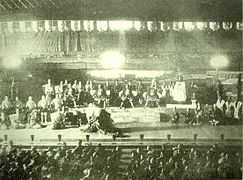Kabukiza
The Kabukiza even Kabukiza , ( jap. 歌舞伎座 ., Dt "Kabuki Theater") is the largest Kabuki - Theater of Japan and is in Tokyo district of Ginza . The theater was opened in 1889 and is the only theater to show kabuki performances in one continuous season . The current building is the fifth building of the theater.
history
The first wooden theater building from 1889 was based on the ideas of the theater reformer Gen'ichirō Fukuchi and had a western facade with a Japanese interior.
A second theater building from 1911 had a palatial Japanese facade, but was carried out with modern materials and lighting. In 1914, the Shōchiku company took over the theater, which was completely destroyed in October 1921 by a fire caused by a short circuit.
The reconstruction of the theater was interrupted on September 1, 1923 by a fire caused by the Great Kanto earthquake . The new building was completed three years later. The facade combines architectural styles of the Nara - with those of the Momoyama period and was rebuilt on the basis of the remaining parts after its destruction by an American bombing in 1945 and reopened with modern furnishings in January 1951.
In April 2010 the theater was closed, demolished and reopened in April 2013 after reconstruction. At the rear of the property there is now a 149 meter high office building. The facade is identical to that from 1924, but the building is more earthquake-proof and has better access. Today it holds 1,964 spectators. The theater company is still run by Shōchiku today.
construction
The auditorium consists of a parquet floor, two tiers and box seats. A catwalk-shaped front stage, the Hanamichi ( 花道 , "Flower Path ") protrudes into the parquet .
The stage is separated by four heavy, artistically designed curtains, which are pulled up electrically one after the other before the performance. In front of it is the actual, light stage curtain in the traditional colors of the kabukiza black, orange and light green, which is guided sideways and by hand.
The theater has two restaurants and several souvenir and snack shops as well as a museum, in which changing exhibitions show sets, costumes, props and musical instruments as well as documents and models about the history of the theater.
imaginations
The theater offers performances every day, usually both a matinee and an evening performance. These two programs change monthly.
Nowadays, complete pieces are often not performed, but only combinations of individual acts of pieces of different styles, for example an act from a drama, a dance piece and part of a more modern piece. However, a performance can last four hours or more. Fans of famous actors cheer them on at key points with loud calls.
Since the texts are presented in the original early New Japanese , the audience can receive information about the course of the action via headphones. For foreigners there are screens that display translation and stage directions.
During the breaks - including in the auditorium itself - people eat and drink, especially during the longer break, many spectators eat a full meal.
For the back of the second tier, tickets are also sold to visit just one act, which can last between half an hour and two hours, which is often used by Western tourists.
In the course of the COVID-19 pandemic , performances were suspended from March to August 2020.
Web links
- Website. (Japanese).
- Kabukiza Theater. In: Kabuki . (English, Kabukiza Theater on Kabuki Web).
Individual evidence
- ↑ Elaine Lies: Japan's kabuki theater resumes, socially distanced, after coronavirus hiatus. In: Reuters . August 1, 2020, accessed on August 1, 2020 .
Coordinates: 35 ° 40 ′ 10.3 " N , 139 ° 46 ′ 4.8" E










